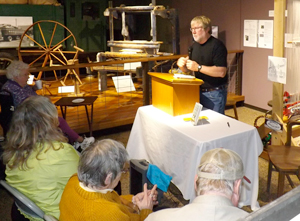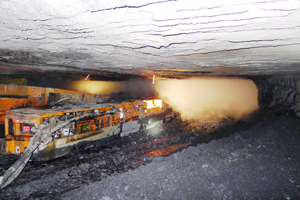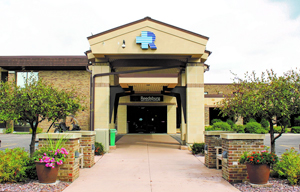Oct 04, 2017
Pulmonary Health in Rural America: Cause and Impact of Work-Related Lung Diseases
This is the second of a two-part series focused on lung diseases in rural areas. Read part one – Bringing Change for Rural COPD Patients: Possibilities with the COPD National Action Plan

Bending down was the last thing he remembered. On a hot day in 1988, Jerry Nelson, South Dakota dairy farmer-turned-author, columnist, and public speaker, stirred the manure a bit. He bent down to unplug the manure pit pump and his world went black.
"My guess is when I stirred that manure pile, it burped a little hydrogen sulfide, and as I leaned down to deal with the pump, I stuck my head into that deadly layer of hydrogen sulfide gas," Nelson said. "I was on respiratory support and in intensive care for several weeks. It's only by a series of miracles that I survived. Six weeks after I got out of the hospital, my pulmonologist checked my lung function; it was normal and still is. I'm lucky."
Nelson is perhaps the unofficial national spokesperson regarding manure pit gas dangers because he actually survived an exposure. He has publicly shared his story dozens of times and still finds himself doing one-on-one education when interviewing farmers for his column.

"Manure pits produce 3 major gases," Nelson said. "Carbon dioxide can suffocate you, methane is explosive, but it's the hydrogen sulfide that causes the quick death. It's on par with cyanide. At high levels, it causes instant death, affecting your nervous system, stopping your heart, stopping your breathing, burning your lungs."
Manure pits are part of many livestock operations. Though pit gas exposure events are infrequent, they are usually deadly. As Nelson points out, they're just one of many hazards associated with agriculture.
"On the farm, there's always something waiting to kill you," Nelson said.
Replace the word "farm" with almost any other rural occupation and Nelson's comment still applies. Workplace protection of visible body parts — arms, legs, head, skin and eyes – is common sense. As Nelson's experience shows, just because the lungs are hidden from sight doesn't mean they're less susceptible to occupational injury. Dr. Philip Harber, pulmonologist, occupational medicine physician, professor, and researcher at the University of Arizona's Mel & Enid Zuckerman College of Public Health, said that the lungs are a major interface with the external world.
Air hazards are much less obvious than the traditional safety hazards but are equally important.
"We breathe in a lot of air every day," Harber said. "And we breathe it in under a lot of different circumstances. Air hazards are much less obvious than the traditional safety hazards but are equally important."
Specific Pulmonary Health Hazards Are Associated with Rural Agriculture, Manufacturing, Construction, Mining — and Healthcare
Rural economic sectors have specific work-related lung problems, referred to as occupational lung diseases or occupational pulmonary diseases. For example, two common agricultural work-related lung diseases are farmer's lung, or hypersensitivity pneumonitis, and idiopathic pulmonary fibrosis (IPF). Farmer's lung is triggered by bacteria, molds, and fungi in hay and other grains. IPF, though originally thought to have no clear cause, was found to have an association with animal feed, dust and pesticide exposure, according to world-wide data reviewed by several Nebraska researchers.

A respiratory problem associated with the manufacturing industry is obliterative bronchiolitis, a lung disease associated with the chemical diacetyl, often found in coffee-processing or food flavoring production, like popcorn butter flavoring.
Both rural construction and mining industries have significant dust-related lung diseases, tucked under the common label "pneumoconiosis," a word meaning "dusty lung." For construction workers, the bothersome dust is silica, the most common mineral in the earth's crust. Present in almost every kind of rock, it causes the work-related lung disease, silicosis. According to the Occupation Safety and Health Administration (OSHA), silica dust exposure impacts the lung health of nearly 2 million construction workers and 300,000 workers in general industries.
Mining in particular is associated with a variety of dusts. Coal miners have decades of experience dealing with their occupational lung disease, Black Lung, or coal miner's pneumoconiosis. This debilitating lung disease was common in coal fields prior to the 1970s. After passage of the Federal Coal Mine Health and Safety Act of 1969 (replaced by the Federal Coal Mine Safety and Health Act of 1977) and by using recommended preventive practices, the prevalence dropped off. Surveillance of working coal miners demonstrated "historic lows in the 1990s." But in recent years, disease rates have increased. Former miners are also at risk since Black Lung is a chronic, progressive disease. For example, in 2016, a cluster of Black Lung's most severe form — progressive massive fibrosis (PMF) – was discovered in Kentucky. Why this disease has resurfaced is not fully understood yet, but silica in coal dust appears to be an important issue. Public health officials have said that "effective dust control, enhanced educational outreach, and improved surveillance are needed to protect the respiratory health of U.S. coal miners."
In addition to rural agricultural, manufacturing, and mining workers, rural healthcare workers, both clinical and non-clinical staff, also have exposure risks — from both patients and their work environment. One risk, of course, is highly contagious respiratory infections. But there are many other risks, such as procedural smoke from operating room lasers and electrosurgical tools, along with waste anesthetic gases. For lab workers, multiple chemicals associated with blood and body tissue processing can be toxic. Lung health risks are also associated with cleaning and sterilization chemicals. Even respiratory therapists and nurses may find themselves exposed to risks from aerosolized medications.
Asthma: An Important Work-Related Lung Health Problem
Another work-related lung health problem is asthma, the "most prevalent occupational lung disease," according to the National Institute for Occupational Safety and Health (NIOSH). Multiple triggers associated with multiple rural occupations can cause asthma, a disease of airway inflammation, causing cough, wheeze, and shortness of breath. Approximately 17% of all adult-onset asthma cases are work-related. For those workers with pre-existing asthma, work-exacerbation prevalence ranges from 22% to 58%. According to an academic study reviewing asthma costs in 2007, overall work-place productivity losses due to asthma morbidity and mortality accounted for $3.8 billion and $2.1 billion respectively. Of additional note are the results of a recent study, funded by the Centers for Disease Control and the National Institute of Health, adding more data to the possibility of a work-related link between asthma and disinfectants used by hospital nurses — especially nurses working in smaller hospitals.
Cancer: Yet Another Occupational Lung Problem
No occupational pulmonary health list is complete without including the work-related particles associated with lung cancer. Asbestos, found in fire-resistant insulation, has a well-known link with cancer. Radon, particularly problematic for uranium miners, is the leading cause of non-smoking-related lung cancers. Diesel exhaust exposure, another risk for miners, has also been linked to lung cancer.
End Stage Lung Disease: The Common Endpoint
What do all these workplace respiratory diseases have in common? Whether they are invisible or visible, have an odor or are odorless, the toxic chemicals, fumes, gases, and vapors travel on inhaled air, bumping into bronchial tubes causing irritation and damage, finally ending up in the lung air sacs. In the air sacs, known as alveoli, these particles can trigger more than just local damage. They may actually find their way into the rest of the body if they are absorbed into the blood stream during the air sacs' process that exchanges carbon dioxide for oxygen.The end result of this disruptive process in the bronchial tubes and air sacs can often be a restrictive lung problem, causing difficulties in being able to take enough air in. In other situations, it's an obstructive problem, or difficulties getting air out.
Medical providers will often use several different phrases describing these lung problems, such as "interstitial lung disease" or "restrictive lung disease." Sometimes the label is "COPD," short for chronic obstructive pulmonary disease. A provider might even use the phrase "end stage lung disease," which describes lungs that can no longer do their vital job of moving carbon dioxide out of the body and life-sustaining oxygen in.
Prevention Strategies
To prevent occupational lung disease, experts endorse a "hierarchy of controls," starting with eliminating hazardous materials, or substituting less hazardous materials. Next, comes a focus on engineering designs, administrative and work practices, along with use of personal protective equipment (PPE).
But education is also a must. Workers themselves must learn how to identify and avoid hazards. They must recognize early signs of disease, recognition that can be assisted by medical surveillance programs.
Compliance information and guidelines for these strategies are found in federal regulations, educational programs, and on-site monitoring for many occupational exposures.
Critical Access Hospitals: Prevention Insights

For healthcare workers, where inhalation hazards come from both patients and the workplace, protection needs differ. That means protective safety equipment must match exposure risk. Stocking the correct PPE to meet different requirements can be a challenge for small, rural, and Critical Access Hospitals (CAH). Reedsburg Area Medical Center (RAMC), a CAH in Reedsburg, Wisconsin, was showcased by the Joint Commission (a hospital accreditation organization) as a case study for their PPE management.
Located in an area where farming and recreation are the major economic drivers, RAMC has streamlined their PPE inventory and training cycle. According to Rita Schara, RN, BSN, Director of Patient Safety & Quality, the success of their effort comes in part from attention to feedback from both clinical and non-clinical staff – those who actually use the safety equipment.
Our non-clinical staff have a perception of the environment that doctors and nurses sometimes forget about, like really valuable insight into mask sealing, pressure valves checks, and other aspects of protection.
"Clinicians focus on what's best for the patient," Schara said. "But we have to think about what's best for the worker, too. Our non-clinical staff have a perception of the environment that doctors and nurses sometimes forget about, like really valuable insight into mask sealing, pressure valves checks, and other aspects of protection."
Peg Dobrovolny, RN, BSN, CIC, RAMC's Infection Control and Preventionist, pointed out that bioterrorism issues over fifteen years ago made their organization more attentive to both the patient and health worker side of respiratory health and other occupational hazards, such as inhaled chemical exposures.
"We have great collaborative networks, from our own organization's emergency teams, and the community EMS and paramedics – who are the first eyes on affected patients – along with other neighboring facilities," Dobrovolny said. "We learn side by side when we're training and retraining. It's an intense effort that we hope we never have to use."
Dobrovolny and Schara also said that both the Division of Public Health of Wisconsin's Department of Health Services and the Wisconsin Hospital Association have provided critical support of these respiratory health efforts and prevention programs, understanding the varied occupational needs within hospitals of all sizes.
Agricultural Preventive Efforts: Early Recognition Paired with Respirator Use
 Carolyn Sheridan, registered nurse and agrimedicine
instructor, is the clinical director for AgriSafe, a non-profit
international organization focused on reducing the
agricultural community's health disparities. Sheridan
said she is concerned that her target audience's
overall health – lung health included – always
takes a back seat to the safety emphasis.
Carolyn Sheridan, registered nurse and agrimedicine
instructor, is the clinical director for AgriSafe, a non-profit
international organization focused on reducing the
agricultural community's health disparities. Sheridan
said she is concerned that her target audience's
overall health – lung health included – always
takes a back seat to the safety emphasis.
And think about it: we would have read about him having lost both hands, but we'd never read that he is struggling to take every breath, day in and day out, and can no longer be involved in the occupation he loves.
"We don't forget that person who lost both his arms in a farming accident," she said. "If you ask a chronic lung disease patient missing both hands whether good lungs or both hands are more important, good lungs would probably win. And think about it: we would have read about him having lost both hands, but we'd never read that he is struggling to take every breath, day in and day out, and can no longer be involved in the occupation he loves."

Sheridan leads AgriSafe's Lungs for Life program. She said she brings a unique perspective to agricultural workers' respiratory health because of her many years working in a small, rural Iowa hospital. Sheridan remembers patients who had gallbladder surgery or were hospitalized for stomach problems, perhaps with a "side diagnosis of chronic obstructive pulmonary disease" that never received any attention.
"Two decades ago, farmers would come in year after year after year with severe bronchitis, and be very short of breath," Sheridan commented. "But we'd never think about it other than as a side problem that sometimes needed oxygen, inhalers, or steroids. We didn't think to recommend respirator use, or discuss prevention, a strategy that could have really made a difference."
Today, Sheridan joins thousands of other health and safety professionals who are knowledgeable and passionate about bringing a prevention focus to agricultural workers, mirroring what the mining and manufacturing sectors offer their workers. As a prevention educator, Sheridan is quick to point out that "holding your breath is never the right strategy." She believes that some day choosing a respirator will be as simple as choosing the right windshield wiper: the worker would understand the benefit of personal protection, walk into a big box store, review the displayed respirator information, and be able to choose the right device.
"First, we need that prevention effort," Sheridan offered. "Then we need our frontline healthcare practitioners to be involved with early recognition so we can back these patients up a bit with their disease process. If we can isolate the trigger and stop the exposure, we can reduce symptoms and increase their time in their occupation, before they can't work because they can't breathe."
Respirators: A System Rather than a Device

Harber, the Arizona professor, adds support to Sheridan's respirator emphasis. He also believes respirators should be looked at not just as a protective device, but as a protective system.
"Modern respiratory devices are pretty good, in contrast to inverted pig bladders used in ancient times or the cowboy's bandana," Harber said. "Today's respirators filter and capture contaminants quite effectively, with very little work of breathing. But a lot of respiratory protection is failing now because it's simply not being used or being used incorrectly. Whether it's at the hospital, in an ag setting, or even in well-supervised industrial settings, the respirator may be fine, but only if it's used. It's a system. It includes motivation, the right respirator, used at the right time, with the correct knowledge on how to use it."
It's a system. It includes motivation, the right respirator, used at the right time, with the correct knowledge on how to use it.
Harber also shares Sheridan's perspective on occupational lung disease: it must include a focus on overall health as well as lung health of the workers. But he adds a caveat.
"When we talk about occupational pulmonary health, we shouldn't be thinking about diseases that are caused by work alone," Harber said. "We need to think about how someone's respiratory health affects their ability to work, whether in agricultural work or any other rural setting. For example, if you've got asthma, what can be done so you can continue to do your work? What are special protection needs? How can you optimize your treatment so you can remain productive? We also have to think about lung health in terms of the environment, especially for workers like in agriculture, who not only work in an environment, they live there."
Experts also say it's important to consider four generalizations about most occupational lung diseases:
- There is often a lag time between exposure and symptoms, sometimes up to several decades.
- When symptoms do begin, occupational causes are often under-recognized and the opportunity for any possible preventive action and treatment is lost.
- Disease course is impacted by factors such as other medical problems, family history, and smoking history.
- There are no cures for these work-related respiratory health problems, so prevention is key.
NIOSH: Work-Related Pulmonary Health

Dr. David Weissman, Director of NIOSH's Respiratory Health Division, emphasized the keys to decreasing work-related lung issues.
"The biggest issue is recognition and prevention," Weissman said. "Recognition of work-related exposures' contributions to respiratory disease is critical. There is a lot of information out there about the burdens of work-related asthma, COPD, and lung cancer. And these diseases are not just caused by cigarette smoking. So it's important to recognize that the way to prevent those conditions or to minimize their severity is to reduce hazardous work exposures."
Weissman said NIOSH can assist with occupational respiratory health in several ways. Along with extensive website information, NIOSH can also provide support through their health hazard evaluation program. In addition to NIOSH help, he also said that extension services provided by land-grant colleges and universities can be a source of valuable assistance for rural areas.
"No matter what that work exposure is," Weissman said, "what we want to avoid is people ending up with potentially preventable lung disease."
Resources
- American Thoracic Society: Work-Related Lung Diseases
- National Library of Medicine: Haz-Map

